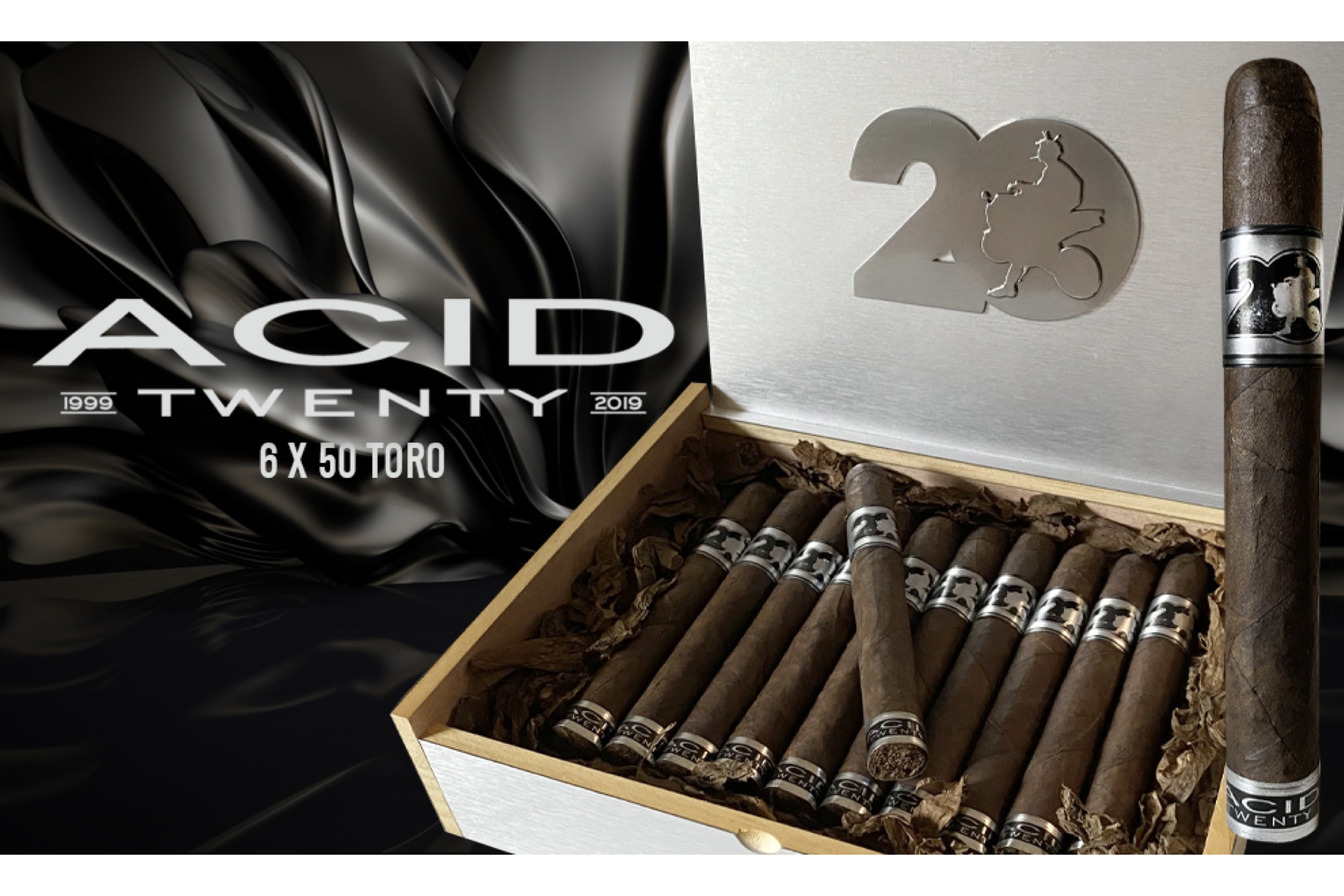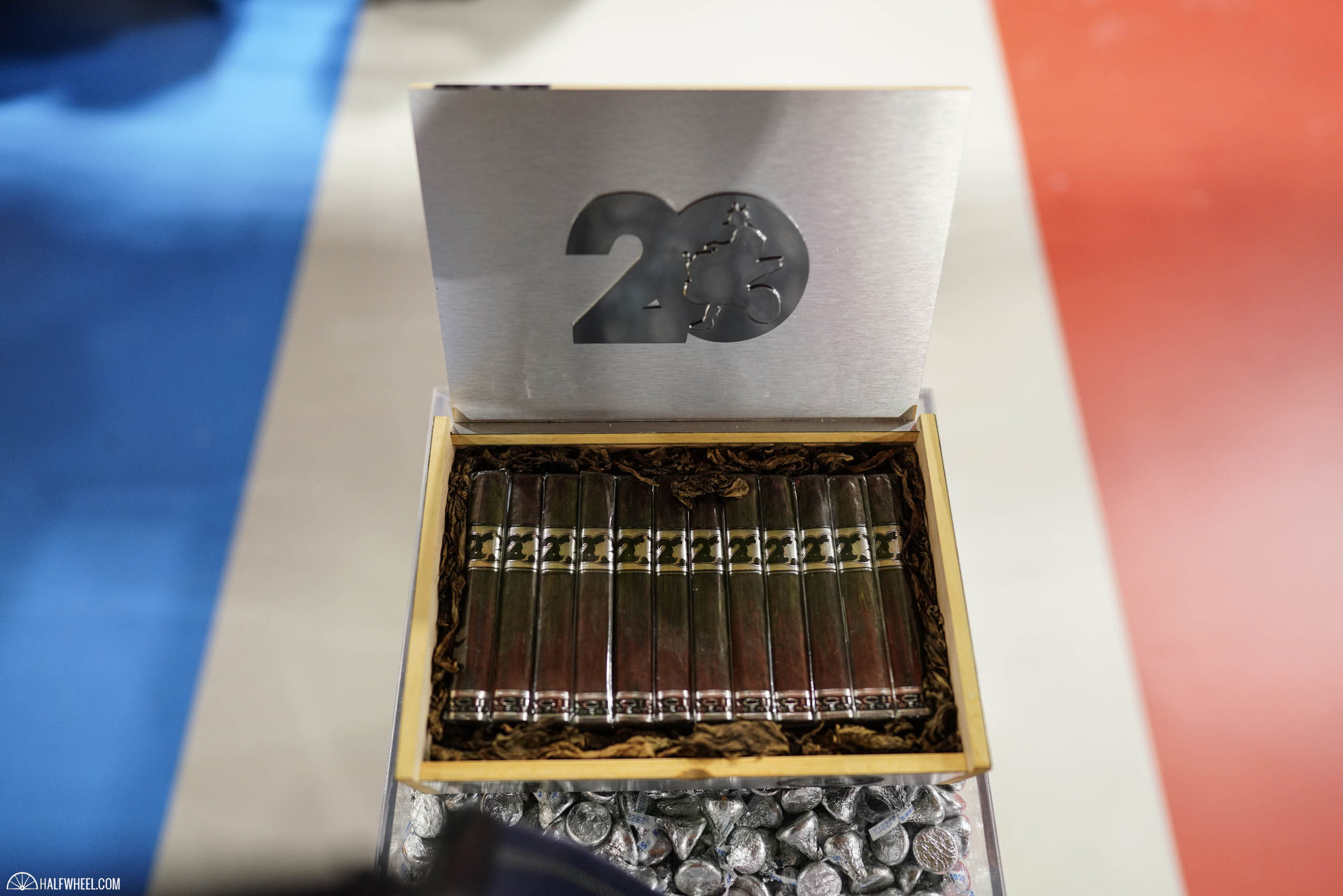During the 2019 IPCPR Convention & Trade Show, Drew Estate showed off not one, but two different new blends being released specifically to commemorate the 20th anniversary of the ACID brand. The first was Kuba Arte, a 5 13/16 x 54 belicoso that was released in July 2019 as a collaboration with five different Brooklyn graffiti artists from New York who produced original art wrapped around seven different water tower boxes the cigars are packaged in.
One month later, Drew Estate shipped the second release celebrating the anniversary: the appropriately named ACID 20. Unlike the Kuba Arte, the ACID 20 is packaged in more traditional boxes—albeit with a flashy chrome and black motif—and debuted in a 5 x 52 box-pressed robusto instead of a belicoso. It’s also a regular production cigar that is now getting extensions.
Recently, Drew Estate added both a second size and a brand new packaging option to the line; specifically, a 6 x 50 round toro priced at $9.68 per cigar or $232.34 for each box of 24. The original robusto size will now be offered in a tubo packaging option priced at $9.85 or $49.25 for each box of five.
Blend-wise, all of the ACID 20 vitolas incorporate the same Mexican San Andrés wrapper covering an Indonesian binder as well as filler tobaccos sourced from Nicaragua. The company says that it is finished with an infusion that is “truly unique, and worthy of the double decade title.”
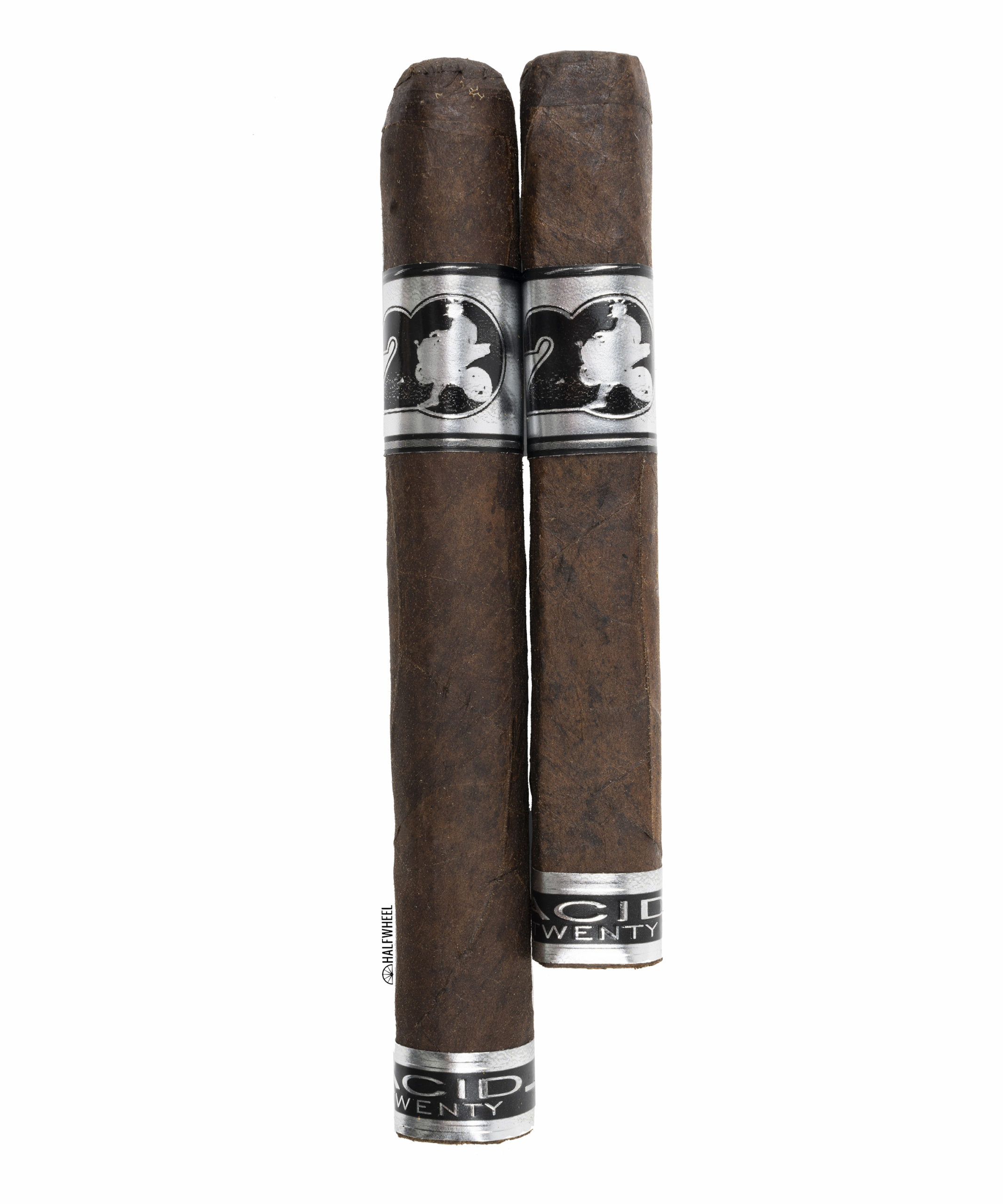
- ACID 20 Toro (6 x 50) — $9.68 (Box of 24, $232.34)
- ACID 20 Robusto (5 x 52) — $9.60 (Box of 24, $230.40)
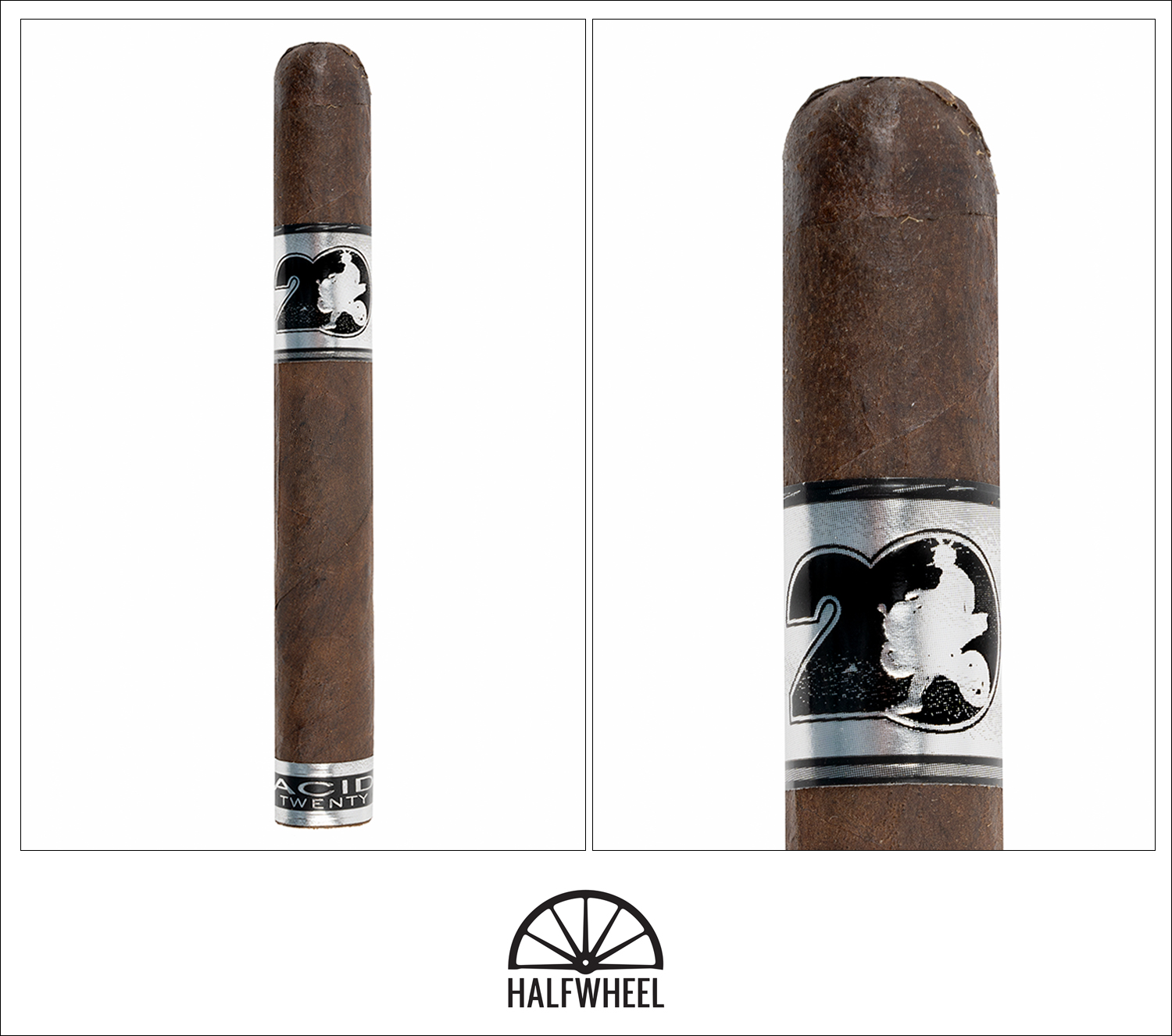
- Cigar Reviewed: ACID 20 Toro
- Country of Origin: Nicaragua
- Factory: La Gran Fabrica Drew Estate
- Wrapper: Mexico (San Andrés)
- Binder: Indonesia
- Filler: Nicaragua
- Length: 6 Inches
- Ring Gauge: 50
- Vitola: Toro
- MSRP: $9.68 (Box of 24, $232.34)
- Release Date: June 2020
- Number of Cigars Released: Regular Production
- Number of Cigars Smoked For Review: 3
Even through the cellophane, the aroma of the ACID 20 is aggressive with potent notes of cloves, pineapple, cinnamon, allspice, grapefruit, perfume, earth and leather to go along with its extremely dark brown wrapper. While the wrapper looks great visually under the highly reflective silver and black of the main band, it is also extremely toothy—almost like coarse sandpaper—and is covered in copious amount of oil. After cutting the cap, the cold draw brings flavors of cloves, almond paste, cinnamon, orange peel, tart lemon citrus, milk chocolate and herbs.
It is impossible not to notice the saccharine sweetness that covers the cap of the ACID 20th, and it is not a great introduction to the cigar. After lighting the foot, the flavors start-up quickly, some of which nearly identically mirror the cold draw: cloves, orange peel, cinnamon, sweet hay, creamy peanuts, earth and powdery cocoa. There is an unmistakable floral sweetness on the finish that already seems to be dissipating, while the spice on my tongue and pepper on the retrohale actually seem to be getting stronger. Construction-wise, the draw is excellent after a straight cut while the burn is very close to razor-sharp and the smoke production is both dense and thick off of the foot. In terms of strength, the ACID 20 starts out a bit past the mild mark, and while it does increase enough to get closer to medium, it seems to stall about halfway there by the time the first third comes to an end.
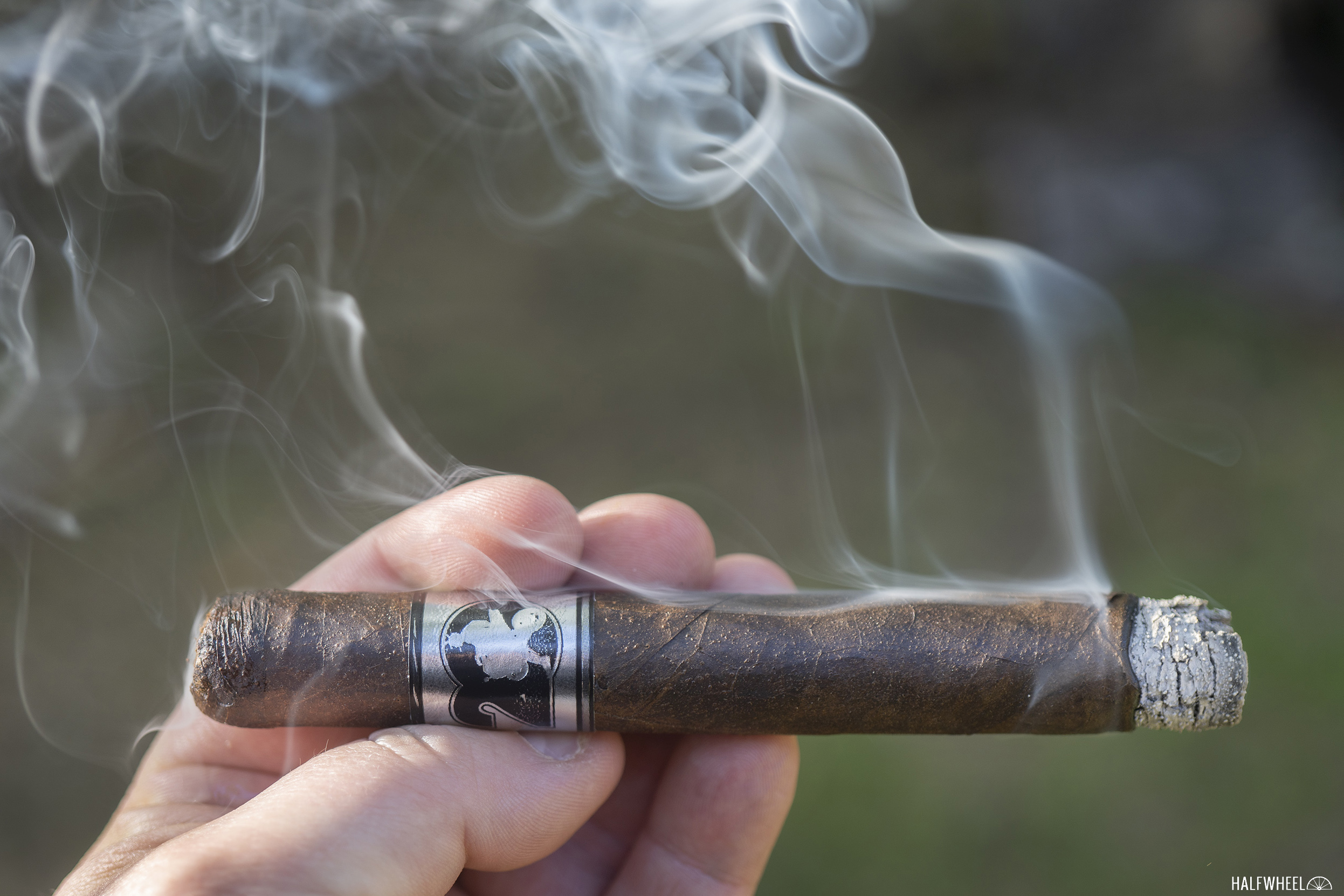
As the second third of the ACID begins, the sweetness on the cap has disappeared for the most part, while the infused flavors begin to subside noticeably, replaced by more traditional notes of freshly brewed sweet tea and cedar followed by lesser flavors of pecans, leather, sweet hay, oak, citrus, cloves and cinnamon along with just a touch of floral. There is also quite a bit of fruity sweetness on the finish that reminds me strongly of plums, along with some slight spice on my lips and a bit of black pepper on the retrohale. The overall construction continues to be excellent in all aspects, and while the strength does increase a bit, it still fails to reach the medium mark by the end of the second third.

The more traditional tobacco flavors really begin to shine during the final third of the ACID Toro, in direct correlation to how little of the infused flavors are left in the profile. The dominant flavors shift again, this time to a combination of roasted espresso beans and cocoa nibs on the palate with secondary notes of brewed sweet tea, milk chocolate, cinnamon, leather, cedar, leather tack and hay. While the floral sweetness has faded from the finish, it has been replaced by a honey sweetness that combines much more naturally with the black pepper and spice that are still present on my tongue and the retrohale respectively. The overall construction ends the same way it began—i.e. amazing in all aspects—while the strength manages to get very close to the medium mark just as I put the nub down with a little more than an inch remaining.

Final Notes
- Honestly, while I understand its purpose, the sweetened tip is considerably less desirable on my palate than the infused flavors in the actual smoking profile, although it does pretty much disappear by the end of the first third.
- Along with the above, I feel that this cigar would be significantly more enjoyable to traditional cigar smokers without the sweetened tip, and wonder if Drew Estate would consider releasing some future blends sans that feature for people to try.
- Joe Gro, digital marketing manager at Drew Estate, explained to me that both the ACID 20 and the Kuba Arte were blended specifically to try and make infused cigars “more approachable” to traditional cigar smokers. This is evident in the fact that the most intense infused flavors are front-loaded—i.e. are at their most intense in the first third before diminishing rapidly in the final two thirds—which was the case in the Kuba Arte I reviewed as well.
- The construction on these cigars was nothing short of amazing: not only did the ash stay on the foot of the cigar well past the first third for each sample, but the draw was absolutely ideal and I only had to touch up one cigar one time between all three sticks I smoked for the review.
- This is one of those cigars where the final score does not tell the whole story: due to the extremely potent infused flavors and the sweetened cap that was only present in the first third, the balance for that part of the cigar suffered quite a bit. Since the second and final thirds featured quite a bit less of each—the final third was virtually devoid of both—the overall balance in the profile was restored for the most part.
- Drew Estate advertises on halfwheel.
- The cigars smoked for this review were purchased by halfwheel; however, Drew Estate did sent additional cigars that were not smoked as part of this review.
- Final smoking time averaged one hour and 34 minutes for all three samples.
- If you would like to purchase any of the ACID 20 Toro, site sponsors Atlantic Cigar, Cigar Hustler, Corona Cigar Co., JR Cigar and STOGIES World Class Cigars all have them in stock.
Even after all the years I have been smoking, I am constantly surprised at how much less pervasive the flavors in most infused cigars are on the palate as opposed to what is present in the aroma. That is definitely the case with the ACID 20. While both the saccharine sweetness on the cap and the fruity aroma are almost shockingly aggressive—the latter almost knocked me off my feet the first time I smelled it, even before taking the cellophane off—the actual profile bears very little of either after the first third. In fact, the second and final thirds are full of more traditional cigar flavors and significantly improved balance, as well as the same amazing construction for both the burn and draw. Infused cigars tend to get a bad rap from some of the cigar-smoking public, but there is plenty to love about the ACID 20 as long as people are willing to give it a fair chance.

